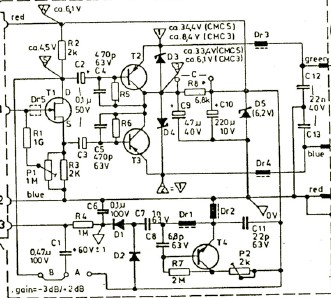RuudNL
Well-known member
I have been experimenting with the classical Schoeps circuit:

I noticed that there was a lot of difference in self noise between circuits, even with noise selected transistors and FETs.
After some searching, I noticed that the noise was caused by a zener diode. (D5)
In my case the zener is 7.5 V / 500 mW.
I tried to increase the value of C10 to 470 uF, but still there was a difference...
Strange that even 470 uF doesn't completely 'kill' the zener noise.
To get proof of the fact that the noise was effectively generated by the zener, I exchanged this part from the 'quiet' circuit to the circuit under test.
And indeed... now the test circuit was as quiet as quiet can be!
So my question: is there such a thing as 'low nosie zener diodes'? And if so: where do I get them?
(I saw the datasheet of the low noise 1N4100, but I can't find where they sell them!)
I already tried to test 100 'standard' 7.5 V / 500 mW zeners, but they were all noisy as hell! Who knows more about this?

I noticed that there was a lot of difference in self noise between circuits, even with noise selected transistors and FETs.
After some searching, I noticed that the noise was caused by a zener diode. (D5)
In my case the zener is 7.5 V / 500 mW.
I tried to increase the value of C10 to 470 uF, but still there was a difference...
Strange that even 470 uF doesn't completely 'kill' the zener noise.
To get proof of the fact that the noise was effectively generated by the zener, I exchanged this part from the 'quiet' circuit to the circuit under test.
And indeed... now the test circuit was as quiet as quiet can be!
So my question: is there such a thing as 'low nosie zener diodes'? And if so: where do I get them?
(I saw the datasheet of the low noise 1N4100, but I can't find where they sell them!)
I already tried to test 100 'standard' 7.5 V / 500 mW zeners, but they were all noisy as hell! Who knows more about this?




![Electronics Soldering Iron Kit, [Upgraded] Soldering Iron 110V 90W LCD Digital Portable Soldering Kit 180-480℃(356-896℉), Welding Tool with ON/OFF Switch, Auto-sleep, Thermostatic Design](https://m.media-amazon.com/images/I/41gRDnlyfJS._SL500_.jpg)




























